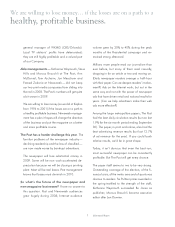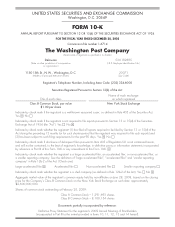Washington Post 2008 Annual Report Download - page 18
Download and view the complete annual report
Please find page 18 of the 2008 Washington Post annual report below. You can navigate through the pages in the report by either clicking on the pages listed below, or by using the keyword search tool below to find specific information within the annual report.Cable Television Operations
At the end of 2008, the Company (through its Cable ONE subsidiary) provided cable service to approximately
699,500 basic video subscribers (representing about 50% of the 1,391,000 homes passed by the systems) and had in
force approximately 225,000 subscriptions to digital video service and 372,900 subscriptions to cable modem service.
Digital video and cable modem services are both available in markets serving virtually all of Cable ONE’s subscriber
base. The digital video services offered by Cable ONE include certain premium, cable network and local over-the-air
channels in HDTV. Cable ONE also completed introduction of its voice over Internet protocol (“VoIP”), or digital
telephone, service in 2008. At year-end, Cable ONE provided VoIP service to 93,500 customers, and the service is
currently available to 95% of the homes passed.
In January 2008, Cable ONE purchased some cable systems in the Mississippi area, near our Cleveland, MS system,
which passed 14,000 homes and served 6,650 basic customers.
The Company’s cable systems are located in 19 midwestern, southern and western states and typically serve smaller
communities. Thus, 5 of the Company’s current systems pass fewer than 10,000 dwelling units, 36 pass 10,000–
50,000 dwelling units and 5 pass more than 50,000 dwelling units. The two largest clusters of systems (each of which
currently serves more than 80,000 basic video subscribers) are located on the Gulf Coast of Mississippi and in the Boise,
ID, area.
In December 2006, Cable ONE purchased in the FCC’s Advanced Wireless Service auction approximately 20 MHz of
spectrum in the 1.7 GHz and 2.1 GHz frequency bands in areas that cover more than 85% of the homes passed by
Cable ONE’s systems. This spectrum can be used to provide a variety of advanced wireless services, including fixed and
mobile high-speed Internet access using WiMAX and other digital transmission systems. Licenses for this spectrum have an
initial 15-year term and 10-year renewal terms. Licensees will be required to show that they have provided substantial
service by the end of the initial license term to be eligible to renew, but there are no interim construction or service
requirements. Cable ONE is evaluating how best to utilize its spectrum, but has no plans to offer any wireless services in
the immediate future.
Regulation of Cable Television and Related Matters
The Company’s cable, Internet and voice operations are subject to various requirements imposed by local, state and
federal governmental authorities. The regulation of certain cable television rates pursuant to procedures established by
Congress has negatively affected the revenues of the Company’s cable systems. Certain of the other legislative and
regulatory matters discussed in this section also have the potential to adversely affect the Company’s cable television,
Internet and voice businesses.
Cable Television
The Cable Television Consumer Protection and Competition Act of 1992 (the “1992 Cable Act”) requires or authorizes
the imposition of a wide range of regulations on cable television operations. Three major areas of regulation are (i) the
rates charged for certain cable television services; (ii) required carriage (“must-carry”) of some local broadcast stations
and (iii) retransmission consent rights for commercial broadcast stations.
Franchising. As a condition to their ability to operate, the Company’s cable systems have been required to obtain
franchises granted by state or local governmental authorities. Those franchises typically are nonexclusive and limited in
time, contain various conditions and limitations and provide for the payment of fees to the local authority, determined
generally as a percentage of revenues.
Additionally, those franchises often regulate the conditions of service and technical performance and contain various types
of restrictions on transferability. Failure to comply with all of the terms and conditions of a franchise may give rise to rights
of termination by the franchising authority. As discussed below, the Federal Communications Commission (“FCC”) has
adopted rules designed to expedite the process of awarding competitive franchises and relieving applicants for
competing franchises of some locally-imposed franchise obligations. The FCC also has extended certain of these
“reforms” to incumbent cable operators.
Rate Regulation. In 1993, the FCC adopted regulations that permitted local franchising authorities or the FCC to
regulate the rates that cable systems that are not subject to “effective competition” charge for certain levels of cable
service, equipment and service calls. Among other things, the Telecommunications Act of 1996 expanded the definition
of “effective competition” (a condition that precludes any regulation of the rates charged by a cable system) and sunset
(effective April 1, 1999) the FCC’s authority to regulate the rates charged for optional tiers of service. The FCC has
confirmed that some of the cable systems owned by the Company fall within the effective-competition exemption, and the
Company believes, based on an analysis of competitive conditions within its systems, that other of its systems may also
6THE WASHINGTON POST COMPANY
























